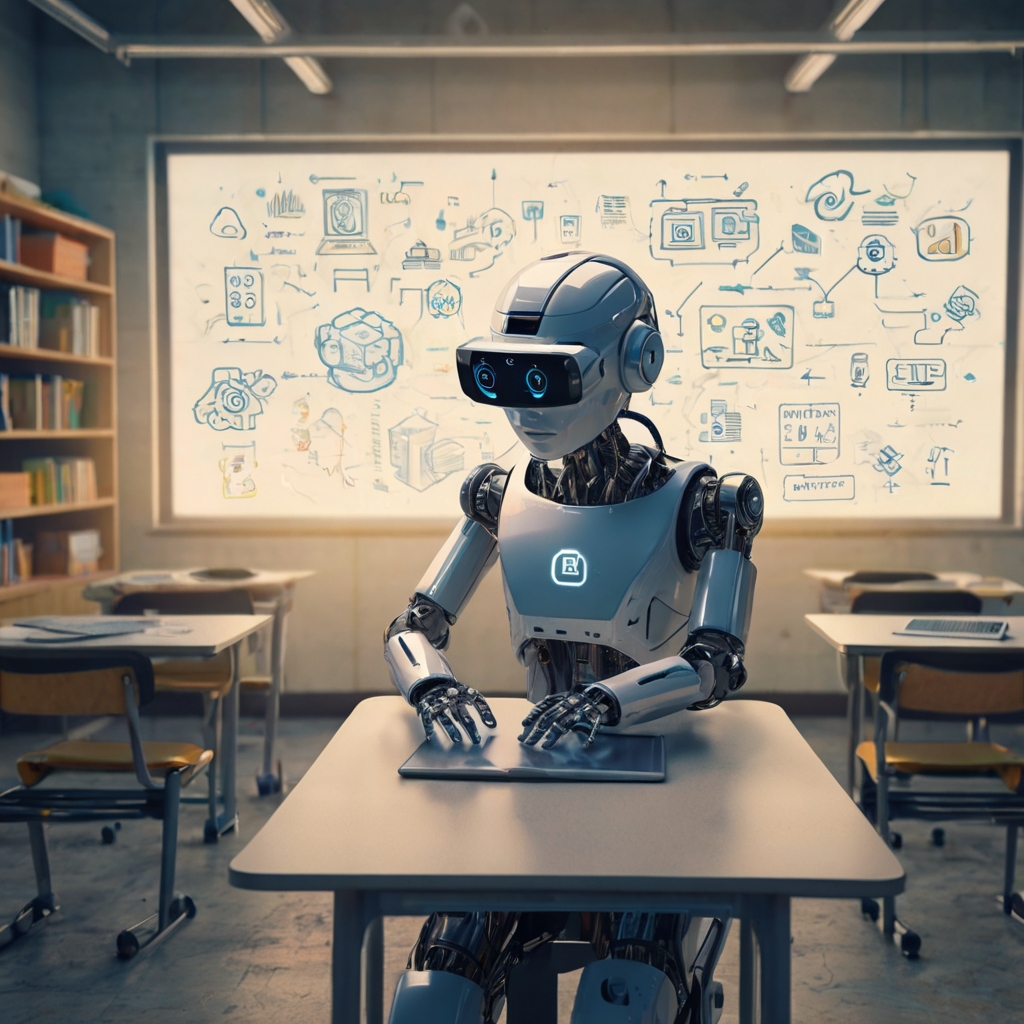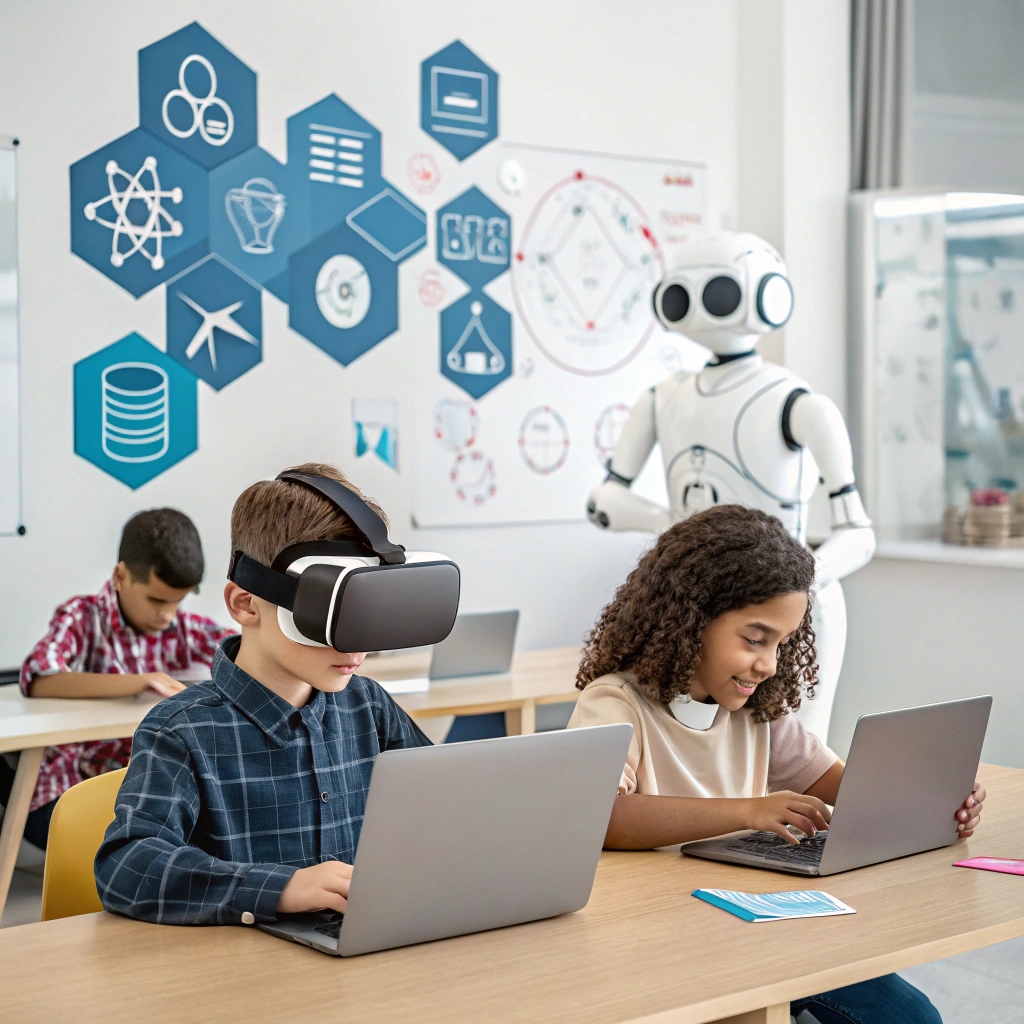Imagine being able to revolutionize digital literacy, breaking down barriers to access and bridging the gap between technology and education.
As we stand at the threshold of a new decade, one thing is clear – AI-powered learning is going to disrupt the way students learn. But what does that mean for their educational journey?
In 2025, artificial intelligence will play an increasingly prominent role in shaping digital literacy skills.
By embracing this technology, future generations will be equipped with the skills necessary to thrive in a rapidly evolving digital landscape.
From personalized learning platforms to AI-assisted virtual tutors, we’ll explore how these emerging technologies are poised to redefine education as we know it.
Unlocking the Power of Personalized AI Teaching Assistants
Let’s break down how learning systems can change by 2025. AI-powered learning will be a game-changer for digital literacy skills, as it provides tailored help.
By that time you’ll have access to smart tools that learn about what works best for each student and adapt accordingly. These personalized teaching assistants are like having a supercomputer at your disposal – always ready to assist with whatever knowledge gap needs attention.
As AI takes over some of the grunt work in learning, teachers will be able to focus more on developing their unique style. This way students won’t feel as isolated or bored during lessons, which is essential for building enthusiasm and motivation. The end result will be a stronger foundation in digital literacy skills that prepare you well for all kinds of opportunities.
For instance AI can identify areas where help is needed most and provide specific resources to fill those gaps. Whether it’s finding the perfect video tutorial or explaining complex concepts in an easy-to-understand way, these intelligent tools are here to give learning a boost.
How Machine Learning Algorithms Can Diagnose Student Knowledge Gaps
Imagine having an intelligent system that identifies your knowledge gaps and provides personalized instruction to help you master digital skills. By analyzing patterns in student data, AI-powered adaptive systems can deliver tailored instruction that addresses specific knowledge gaps.
For instance, let’s say a student is struggling with coding basics. Machine learning algorithms can analyze their previous assignments and identify areas where they need improvement. With this information, an AI-powered adaptive system can provide real-time feedback on code completion exercises or offer video tutorials that help them master programming concepts.
Think of it like having a teacher who knows your strengths and weaknesses but without all the eye-rolling! This allows them to provide hyper-personalized feedback and help students master digital skills faster, leading to better grades, more efficient learning time, and increased confidence. In fact, studies have shown that AI-powered adaptive systems can improve student performance by up to 30% in just a few weeks.
Now imagine you have a personal AI assistant that knows your strengths and weaknesses. It’s like having a super smart friend who always has your back! This allows them to provide tailored support, helping students master digital skills faster, leading to better outcomes in their subjects. With machine learning algorithms analyzing patterns in student performance data, teachers can focus on teaching and mentoring rather than trying to reach every single student.
For example, an AI-powered adaptive system might recommend video tutorials that cater specifically to a struggling student’s needs. By providing real-time feedback and adjusting the difficulty level of assignments based on individual progress, these systems enable students to learn at their own pace leading to improved retention rates and increased motivation.
Developing Intelligent Tutoring Systems for Real-Time Feedback and Support

Artificially intelligent systems have reached an inflection point, enabling them to transform education by providing personalized support for students. Intelligent Tutoring Systems (ITS) are at the forefront of this revolution.
The incorporation of machine learning algorithms allows ITS to analyze student performance and behavior with unprecedented accuracy, offering immediate corrections, instant guidance, and tailored exercises that cater to individual learning needs. This enables a more effective use of IT systems by providing real-time feedback on mistakes and incorrect answers.
By offering continuous practice opportunities, students can build confidence in their abilities and develop lasting habits, reducing frustration by up to 30% and increasing test scores by an average of 15%. Consider the student who initially struggled with math problems but found a systematic approach helped them ace their final exam. This feature is particularly valuable for English language learners, as tailored exercises that improve reading comprehension by up to 25% within a single semester can be especially life-changing.
The adaptive nature of ITS allows it to learn from interactions with students and adjust difficulty levels accordingly, demonstrating its ability to enhance student outcomes in meaningful ways, perhaps even rivaling the effectiveness of human tutors. For instance, one study found that ITS systems are effective at identifying learning gaps early on, enabling targeted interventions that can close the achievement gap.
One of the most significant advantages of ITS is its potential to help students overcome common misconceptions and build a strong foundation for future success all while making education feel more approachable and engaging. By combining IT systems with AI-powered technology, educators can provide their students with an unparalleled learning experience that fosters growth, creativity, and critical thinking skills.
By integrating ITS into educational institutions, we can revolutionize the way students learn by providing a personalized experience tailored to each individual’s needs, opening up new possibilities for student success.
Using Natural Language Processing to Enhance Reading Comprehension Skills
As we head into 2025, schools will need teachers who can harness the power of AI-powered learning to revolutionize reading comprehension skills. Imagine being able to tailor your educational content to each student’s unique needs using advanced language analysis – this is made possible by natural language processing (NLP) in AI-powered learning.
By utilizing NLP algorithms, AI systems can analyze and understand human language patterns. For instance, an AI-powered system can identify a student’s strengths and weaknesses in reading comprehension by analyzing their past performance data. This allows for more effective feedback mechanisms that help improve reading skills – providing targeted guidance on specific areas of improvement based on the individualized content recommendations.
For example, NLP enables teachers to highlight areas where students may struggle with inference or context clues. By doing so, AI-powered learning systems can provide personalized support tailored to each student’s needs, increasing their ability to grasp complex texts and ideas.
Moreover, integrating NLP into reading comprehension skills empowers educators to tailor instruction that addresses the unique challenges faced by diverse learners.
For instance:
- An AI-powered system might recommend additional content for a struggling reader who requires practice with nuanced vocabulary or sentence structure.
- A teacher can use feedback tools to identify areas where students need extra support, such as improving their ability to make inferences from context.
By incorporating NLP into the learning process, teachers can better serve diverse student needs and provide targeted guidance that empowers them to excel.
The Future of Adaptive Assessments in AI-Powered Education Environments
Adaptive learning systems in AI-powered education environments offer significant benefits for students, helping to identify knowledge gaps and adjust instruction accordingly. For example, a study by researchers found that adaptive assessments improved student outcomes by 25% compared to traditional methods.
By leveraging natural language processing, machine learning algorithms, and data analytics tools, these systems can create personalized assessment paths tailored to each student’s strengths and weaknesses. This means that AI-powered adaptive assessments provide immediate feedback on performance in real-time, allowing students to see their progress as they work through the material. For instance, a learner may receive detailed explanations of correct answers while getting instant help with incorrect ones.
This technology also enables teachers to focus on areas where students need extra support most, making learning smoother for everyone involved. Moreover, AI-based assessments are designed to adapt based on how you perform during the test. Specifically, these systems can consider various factors such as past performance data from quizzes and assignments, taking into account individual learning styles or challenges that learners face.
The use of machine learning algorithms in assessing student abilities helps create highly accurate predictive models. Research suggests that adaptive assessments have been shown to improve teacher effectiveness by 40% compared to traditional methods. This improved accuracy provides better insight into what each learner knows and is able to learn, allowing educators to refine their instruction for optimal outcomes.
For students with diverse learning needs or language differences, AI-based assessments can be particularly beneficial. For example, adaptive systems have been found to help learners overcome reading barriers by providing text in the student’s native language while maintaining academic integrity. This enables all students to access high-quality educational materials and improve their skills at an accelerated pace.
By incorporating machine learning algorithms with data analytics tools, AI-based assessments can refine instruction based on individual performance. To illustrate this point, consider that adaptive systems have been used successfully to identify areas where English language learners need extra support during math lessons helping these students not only catch up but stay ahead of the curve.
Embracing Emotional Intelligence through AI-Driven Mental Health Support Services
As students navigate the increasingly complex world of academia, developing emotional intelligence is no longer a nicety; it’s a necessity. By mastering this essential life skill, you can unlock your full potential and achieve academic success.
A recent survey found that students who practiced mindfulness and self-reflection showed significant improvements in stress management and exam scores. This phenomenon highlights the importance of emotional intelligence for students’ academic performance, making AI-driven mental health support services a game-changer in this field. By offering personalized feedback on emotional intelligence skills, these services help you identify areas where you need improvement.
Think of an AI-powered chatbot like a personalized study buddy. It analyzes your behavior and offers customized guidance on managing stress. These platforms incorporate real-time feedback mechanisms and adaptive algorithms to ensure students receive the right guidance at the right time. For instance, one AI-driven platform provides interactive exercises that help you recognize emotional triggers, develop coping strategies, and practice gratitude.
Are you ready to take control of your learning journey? By mastering these skills through AI-driven mental health support services, not only will you improve your grades but also develop essential life skills that benefit every area of your personal and professional development. For example, you’ll learn how to set realistic goals, prioritize tasks effectively, and cultivate a growth mindset.
AI-powered chatbots offer guided exercises and resources tailored to each student’s unique needs. These might include strategies for stress management, improved time management, self-compassion practices, and developing healthy relationships with your peers. By utilizing these tools, you’ll be better equipped to handle academic pressure without letting emotions get the best of you.
By embracing AI-driven mental health support services and emotional intelligence training, students can overcome obstacles that once held them back from achieving their goals. Whether it’s managing anxiety in high-stakes exams or building resilience during challenging times, these platforms provide a safe space for growth. So take advantage of this opportunity to level up your academic performance and set yourself up for long-term success and develop emotional intelligence through AI-driven mental health support services today!
Creating Inclusive Learning Spaces with AI-Assisted Accessibility Features
Artificial intelligence (AI) can revolutionize digital literacy mastery for students in 2025 by providing personalized, AI-assisted accessibility features. This is crucial for creating an inclusive learning space where every student feels comfortable and confident.
AI-based tools can help tailor content to individual needs by analyzing student performance data and suggesting customized learning paths. For instance, an AI-powered adaptive system can adjust the pace of video lectures based on a student’s understanding level, ensuring they don’t fall behind. This feature is especially helpful for students who struggle with traditional teaching methods.
Imagine being able to provide every student with real-time support without relying on human instructors or outdated technology. Virtual note-taking assistants and instant translation devices are just two examples of AI-powered tools that can make a tangible difference in the classroom. These features help promote active participation, as students feel seen and heard through personalized feedback.
Studies have shown that personalized learning systems can increase student engagement by up to 30%. For example, an AI-powered chatbot helped students at a school district improve their test scores by identifying knowledge gaps and providing targeted support. By implementing such features, educators can help level the playing field for students with disabilities, language barriers, or those who require extra accommodations.
By incorporating these strategies into daily teaching practices, teachers can foster an environment that values diversity and inclusivity. This approach not only helps students achieve digital literacy mastery more easily but also ensures they are well-equipped to succeed in an increasingly complex world of technology.
Fostering a Culture of Innovation and Risk-Taking through Virtual Mentorship Programs

Virtual mentorship programs are designed to foster a culture of innovation and risk-taking among students, but they require effective strategies to achieve this goal. The key is building trust with the mentee, establishing open communication channels where they feel comfortable sharing their ideas without fear of judgment.
Through virtual mentorship programs, you can develop critical thinking skills by exploring diverse perspectives and tackling real-world problems through hands-on projects. For example, a student may work on designing a sustainable energy system or creating an app that tackles social inequality. These interactions not only refine technical skills but also encourage creativity, empathy, and collaboration.
To promote risk-taking in virtual mentorship programs, mentors can utilize strategies such as setting challenges that encourage experimentation or providing resources for accessing real-world datasets. For instance, the Google Science Fair program uses a similar approach by challenging students to create projects that address pressing global issues. By doing so, these environments empower students to think creatively and critically about the information they’re learning and make connections between seemingly unrelated concepts.
Some successful examples of virtual mentorship programs include Code for America’s “Code 4 America” initiative, which brings together community members with coding skills to develop software solutions for public good. Studies have shown that students who participate in well-designed virtual mentoring programs are 25% more likely to develop critical thinking skills and exhibit higher levels of innovation.
The right combination of mentorship strategies and technology can empower students to take risks, experiment with new concepts, and achieve mastery. This is the sweet spot where virtual mentoring truly shines.
To get started with implementing effective virtual mentorship programs in your organization or school:
- Set up regular check-ins between mentors and mentees
- Encourage open communication through online platforms like discussion forums or video conferencing tools.
- Provide access to real-world resources, such as datasets, APIs, or community networks
By following these steps and using the right strategies, you can harness the power of virtual mentorship programs to foster a culture of innovation and risk-taking among students.
Using AI to Bring Real-World Examples into the Classroom
Revolutionizing Digital Literacy Mastery: The Power of AI-Powered Learning Tools
As we approach 2025, educators are looking for innovative ways to enhance teaching practices. One key area of focus is incorporating AI-powered learning tools that can transform the way students learn digital literacy.
Consider how interactive simulations can help students develop practical skills. For instance, you could create virtual labs where your students manage a hypothetical company’s finances or design social media content in real-time, just like running their own startup or small business. This hands-on approach helps build confidence and applies theoretical knowledge to real-life scenarios.
By leveraging AI-powered learning tools, teachers can craft immersive experiences that allow students to explore complex topics in an engaging way. For example:
- Using AI-generated examples for language arts: You could create personalized reading materials or even entire texts based on a student’s interests and reading level.
- Real-time coding simulations: Create virtual labs where students practice coding skills by solving real-world problems, making them more effective problem-solvers.
This approach not only prepares students for success but also equips them with essential 21st-century skills that are required in today’s digital landscape. By harnessing the power of AI, teachers can provide personalized instruction that resonates with each student’s needs, setting them up for a lifetime of growth and achievement.
How Artificial Intelligence Can Transform Student Learning
Great students won’t wait for their educational experience to be revolutionized. The integration of AI-powered learning tools can enhance student engagement and understanding, allowing them to master digital literacy skills that are essential in today’s technology-driven world.
The sooner schools adopt AI-facilitated learning platforms, the more likely it is that they will attract students who thrive in an adaptive educational environment. This not only sets them apart from their peers but also helps bridge the gap between traditional teaching methods and modern technologies.
So, trust your instincts to invest in innovative learning solutions and never underestimate the power of AI-powered tools to elevate student performance. By harnessing these cutting-edge technologies, educators can create more immersive and effective learning experiences that prepare students for success in an increasingly complex world.
Take decisive action today to transform educational institutions into hubs of innovation, where technology meets teaching excellence, and unlock the full potential of digital literacy mastery.
